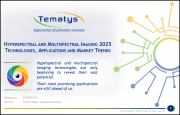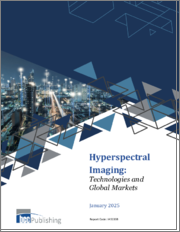
|
시장보고서
상품코드
1596867
세계의 초분광 영상 시장 : 규모, 점유율, 성장 분석, 유형별, 기술별, 파장별, 최종 사용자별, 지역별 - 산업 예측(2024-2031년)Hyperspectral Imaging Market Size, Share, Growth Analysis, By Type, By Technology, By Wavelength, By End-user, By Region - Industry Forecast 2024-2031 |
||||||
세계의 초분광 영상 시장 규모는 2022년에 2억 9,979만 달러였으며, 예측기간(2024-2031년)의 CAGR은 15.43%로 예측되며, 2023년의 3억 4,552만 달러부터 2031년까지 는 10억 8,772만 달러로 성장할 것으로 예측됩니다.
초분광 영상 시장은 첨단 영상 기술에 대한 투자 증가와 다양한 분야에의 응용 범위의 확대가 원동력이 되어, 큰 성장을 이루고 있습니다. 하이퍼 스펙트럼 이미징의 채용이 증가하고 있습니다. 이 기술을 전문으로 하는 기업의 수익 향상이 기대되고 있습니다. 광업 분야에서는 광물과 귀중한 원소에 대한 수요가 높아지고 있습니다. 따라서 투자가 증가하고 있으며, 초분광 영상의 이용이 급증하고 있습니다. 장기적인 시장 성장을 방해할 수 있습니다. 초분광 영상 용도의 진화로 인한 새로운 기회를 충분히 활용하기 위해서는 이러한 제약을 다루어야 합니다. 함께 이러한 장벽을 극복하는 것이 중요합니다.
목차
소개
- 조사의 목적
- 조사 범위
- 정의
조사 방법
- 정보 조달
- 2차 데이터와 1차 데이터의 방법
- 시장 규모 추정
- 시장의 전제조건과 제한
주요 요약
- 세계 시장 전망
- 공급과 수요의 트렌드 분석
- 부문별 기회 분석
시장 역학과 전망
- 시장 개요
- 시장 규모
- 시장 역학
- 성장 촉진요인과 기회
- 억제요인과 과제
- Porter's Five Forces 분석과 영향
- 경쟁 기업간 경쟁 관계
- 대체품의 위협
- 구매자의 협상력
- 신규 진입업자의 위협
- 공급기업의 협상력
주요 시장 인사이트
- 주요 성공 요인
- 경쟁도
- 주요 투자 기회
- 시장 생태계
- 기술의 진보
- 규제 상황
- 밸류체인 분석
- 사례 연구 분석
- PESTEL 분석
- 시장의 매력 지수
- 공급망 분석
- 가격 분석
세계의 초분광 영상 시장 규모 : 제품별·CAGR(2024-2031년)
- 카메라
- 액세서리
세계의 초분광 영상 시장 규모 : 기술별, CAGR(2024-2031년)
- 푸시블룸/라인스캔
- 스냅샷
- 기타 기술
세계의 초분광 영상 시장 규모 : 파장별·CAGR(2024-2031년)
- 가시광선 및 근적외선
- SWIR
- MWIR
- LWIR
세계의 초분광 영상 시장 규모 : 최종사용자별·CAGR(2024-2031년)
- 식량·농업
- 헬스케어
- 방어
- 광업·측정
- 재활용
- 기타
세계의 초분광 영상 시장 규모 : 지역별, CAGR(2024-2031년)
- 북미(제품별, 기술별, 파장별, 최종 사용자별)
- 미국
- 캐나다
- 유럽(제품별, 기술별, 파장별, 최종 사용자별)
- 영국
- 독일
- 스페인
- 프랑스
- 이탈리아
- 기타 유럽
- 아시아태평양(제품별, 기술별, 파장별, 최종 사용자별)
- 중국
- 인도
- 일본
- 한국
- 기타 아시아태평양
- 라틴아메리카(제품별, 기술별, 파장별, 최종 사용자별)
- 브라질
- 기타 라틴아메리카
- 중동 및 아프리카(제품별, 기술별, 파장별, 최종 사용자별)
- GCC 국가
- 남아프리카
- 기타 중동 및 아프리카
경쟁 정보
- 상위 5개사 비교
- 주요 기업의 시장 포지셔닝(2023년)
- 주요 시장 기업이 채용한 전략
- 시장의 최근 동향
- 기업의 시장 점유율 분석(2023년)
- 주요 기업의 기업 프로파일
- 기업 개요
- 제품 포트폴리오 분석
- 기업의 부문별 점유율 분석
- 수익의 전년대비 비교(2021-2023년)
주요 기업 프로파일
- Applied Spectral Imaging Inc.(Israel)
- BaySpec Inc.(US)
- Specim Spectral Imaging Ltd(Finland)(Konica Minolta)
- Corning Inc.(US)
- Surface Optics Corporation(US)
- Headwall Photonics Inc.(US)
- Resonon Inc.(US)
- Telops Inc.(Canada)
- Norsk Elektro Optikk AS(Norway)
- Brimrose Corporation(US)
- Cubert GmbH(Germany)
- ChemImage Corporation(US)
- imec(벨기에)
- ITRES Research Limited(캐나다)
- RIKOLA Ltd.(Finland)(Senop)
- XIMEA GmbH(Germany)
- SpecTIR LLC(US)
- Spectral Imaging Ltd.(UK)
- SPECIM-Spectral Imaging Ltd.(Finland)(Konica Minolta)
- Galileo Group Inc.(Canada)
결론과 권고
JHS 24.12.06Global Hyperspectral Imaging Market size was valued at USD 299.79 Million in 2022 and is poised to grow from USD 345.52 Million in 2023 to USD 1087.72 Million by 2031, at a CAGR of 15.43% during the forecast period (2024-2031).
The hyperspectral imaging market is set for significant growth, driven by increased investments in advanced imaging technologies and a broadening range of applications across various sectors. Key industries such as healthcare, agriculture, environmental monitoring, and defense are seeing a rising adoption of hyperspectral imaging, which is expected to enhance revenue generation for companies specializing in this technology. Particularly, the food and beverages sector places a high priority on quality control, further propelling the demand for hyperspectral imaging solutions throughout the forecast period. Additionally, the mining industry is experiencing an uptick in investments due to heightened demand for minerals and valuable elements, contributing to the anticipated surge in hyperspectral imaging utilization. However, challenges such as the complexity of data analysis and processing, a lack of standardization, portability issues, and limited awareness of its advantages could impede long-term market growth. Companies in this sector must address these constraints to fully capitalize on the emerging opportunities presented by the evolving landscape of hyperspectral imaging applications. As the market evolves, overcoming these barriers will be crucial for sustaining momentum and achieving broader acceptance of hyperspectral imaging technologies.
Top-down and bottom-up approaches were used to estimate and validate the size of the Global Hyperspectral Imaging market and to estimate the size of various other dependent submarkets. The research methodology used to estimate the market size includes the following details: The key players in the market were identified through secondary research, and their market shares in the respective regions were determined through primary and secondary research. This entire procedure includes the study of the annual and financial reports of the top market players and extensive interviews for key insights from industry leaders such as CEOs, VPs, directors, and marketing executives. All percentage shares split, and breakdowns were determined using secondary sources and verified through Primary sources. All possible parameters that affect the markets covered in this research study have been accounted for, viewed in extensive detail, verified through primary research, and analyzed to get the final quantitative and qualitative data.
Global Hyperspectral Imaging Market Segmental Analysis
Global Hyperspectral Imaging Market is segmented by Product, by Technology, by Wavelength, by End User and by Region. Based on Product, the market is segmented into Cameras and accessories. Based on Technology, the market is segmented into Pushbroom/Line Scan, Snapshot, and Other Technologies. Based on Wavelength, the market is segmented into Visible & NIR, SWIR, MWIR, and LWIR. Based on End User, the market is segmented into Food and agriculture, healthcare, defence, Mining and Metrology, Recycling and others. Based on region, the market is segmented into North America, Europe, Asia Pacific, Latin America and Middle East & and Africa.
Driver of the Global Hyperspectral Imaging Market
One of the primary drivers of the Global Hyperspectral Imaging market is its increasing utilization in medical and diagnostic fields. The technology is becoming increasingly popular in healthcare due to its non-invasive nature, particularly in applications such as cancer detection, wound evaluation, and surgical assistance. Hyperspectral imaging excels at producing detailed and spectrally rich images, which allow for the identification of tissue properties and the detection of abnormalities. This capability is facilitating greater adoption of hyperspectral imaging in various diagnostic and medical scenarios, thereby significantly contributing to the market growth in the healthcare sector.
Restraints in the Global Hyperspectral Imaging Market
The global hyperspectral imaging market faces significant restraints due to the inherent complexity involved in data analysis and processing. The technology generates an extensive amount of spectral data, necessitating sophisticated analytical systems and solutions for effective interpretation. This requirement for advanced processing capabilities not only demands a workforce skilled in handling such technology but also involves substantial capital investments for the acquisition of specialized tools. Consequently, these factors are likely to hinder the growth and demand for hyperspectral imaging solutions in the foreseeable future, as organizations grapple with the intricacies of managing and utilizing the vast data generated.
Market Trends of the Global Hyperspectral Imaging Market
The global hyperspectral imaging market is witnessing a significant trend toward the integration of artificial intelligence (AI) and machine learning (ML) technologies. This convergence is enhancing the accuracy and efficiency of hyperspectral imaging solutions, enabling advanced functionalities such as automated classification, pattern recognition, and anomaly detection. As these AI-driven capabilities reduce the dependency on highly skilled personnel for operations, market accessibility expands, attracting a broader range of industries, from agriculture to healthcare. This trend not only optimizes operational workflows but also positions hyperspectral imaging as a pivotal tool in data analysis and decision-making, driving robust growth in the market.
Table of Contents
Introduction
- Objectives of the Study
- Scope of the Report
- Definitions
Research Methodology
- Information Procurement
- Secondary & Primary Data Methods
- Market Size Estimation
- Market Assumptions & Limitations
Executive Summary
- Global Market Outlook
- Supply & Demand Trend Analysis
- Segmental Opportunity Analysis
Market Dynamics & Outlook
- Market Overview
- Market Size
- Market Dynamics
- Driver & Opportunities
- Restraints & Challenges
- Porters Analysis & Impact
- Competitive rivalry
- Threat of substitute
- Bargaining power of buyers
- Threat of new entrants
- Bargaining power of suppliers
Key Market Insights
- Key Success Factors
- Degree of Competition
- Top Investment Pockets
- Market Ecosystem
- Technological Advancement
- Regulatory Landscape
- Value Chain Analysis
- Case Study Analysis
- PESTEL Analysis
- Market Attractiveness Index
- Supply Chain Analysis
- Pricing Analysis
Global Hyperspectral Imaging Market Size by Product & CAGR (2024-2031)
- Cameras
- Accessories
Global Hyperspectral Imaging Market Size by Technology & CAGR (2024-2031)
- Pushbroom/Line Scan
- Snapshot
- Other Technologies
Global Hyperspectral Imaging Market Size by Wavelength & CAGR (2024-2031)
- Visible & NIR
- SWIR
- MWIR
- LWIR
Global Hyperspectral Imaging Market Size by End User & CAGR (2024-2031)
- Food and agriculture
- Healthcare
- Defence
- Mining and Metrology
- Recycling
- Others
Global Hyperspectral Imaging Market Size by Region & CAGR (2024-2031)
- North America, (by Product, by Technology, by Wavelength, by End User)
- US
- Canada
- Europe, (by Product, by Technology, by Wavelength, by End User)
- UK
- Germany
- Spain
- France
- Italy
- Rest of Europe
- Asia-Pacific, (by Product, by Technology, by Wavelength, by End User)
- China
- India
- Japan
- South Korea
- Rest of Asia Pacific
- Latin America, (by Product, by Technology, by Wavelength, by End User)
- Brazil
- Rest of Latin America
- Middle East & Africa, (by Product, by Technology, by Wavelength, by End User)
- GCC Countries
- South Africa
- Rest of Middle East & Africa
Competitive Intelligence
- Top 5 Player Comparison
- Market Positioning of Key Players, 2023
- Strategies Adopted by Key Market Players
- Recent Developments in the Market
- Company Market Share Analysis, 2023
- Company Profiles of All Key Players
- Company Details
- Product Portfolio Analysis
- Company's Segmental Share Analysis
- Revenue Y-O-Y Comparison (2021-2023)
Key Company Profiles
- Applied Spectral Imaging Inc. (Israel)
- Company Overview
- Business Segment Overview
- Financial Updates
- Key Developments
- BaySpec Inc. (US)
- Company Overview
- Business Segment Overview
- Financial Updates
- Key Developments
- Specim Spectral Imaging Ltd (Finland)(Konica Minolta)
- Company Overview
- Business Segment Overview
- Financial Updates
- Key Developments
- Corning Inc. (US)
- Company Overview
- Business Segment Overview
- Financial Updates
- Key Developments
- Surface Optics Corporation (US)
- Company Overview
- Business Segment Overview
- Financial Updates
- Key Developments
- Headwall Photonics Inc. (US)
- Company Overview
- Business Segment Overview
- Financial Updates
- Key Developments
- Resonon Inc. (US)
- Company Overview
- Business Segment Overview
- Financial Updates
- Key Developments
- Telops Inc. (Canada)
- Company Overview
- Business Segment Overview
- Financial Updates
- Key Developments
- Norsk Elektro Optikk AS (Norway)
- Company Overview
- Business Segment Overview
- Financial Updates
- Key Developments
- Brimrose Corporation (US)
- Company Overview
- Business Segment Overview
- Financial Updates
- Key Developments
- Cubert GmbH (Germany)
- Company Overview
- Business Segment Overview
- Financial Updates
- Key Developments
- ChemImage Corporation (US)
- Company Overview
- Business Segment Overview
- Financial Updates
- Key Developments
- imec (Belgium)
- Company Overview
- Business Segment Overview
- Financial Updates
- Key Developments
- ITRES Research Limited (Canada)
- Company Overview
- Business Segment Overview
- Financial Updates
- Key Developments
- RIKOLA Ltd. (Finland)(Senop)
- Company Overview
- Business Segment Overview
- Financial Updates
- Key Developments
- XIMEA GmbH (Germany)
- Company Overview
- Business Segment Overview
- Financial Updates
- Key Developments
- SpecTIR LLC (US)
- Company Overview
- Business Segment Overview
- Financial Updates
- Key Developments
- Spectral Imaging Ltd. (UK)
- Company Overview
- Business Segment Overview
- Financial Updates
- Key Developments
- SPECIM - Spectral Imaging Ltd. (Finland)(Konica Minolta)
- Company Overview
- Business Segment Overview
- Financial Updates
- Key Developments
- Galileo Group Inc. (Canada)
- Company Overview
- Business Segment Overview
- Financial Updates
- Key Developments



















